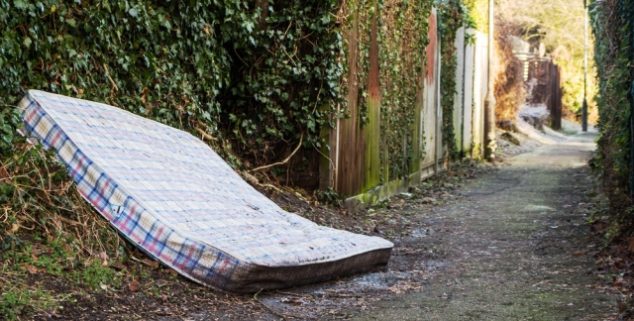Opinion
‘Bye Bye Mattress’ — a program that works
 A mattress illegally dumped in an alley, waiting for recycling. (Photo: Dom J, via Shutterstock)
A mattress illegally dumped in an alley, waiting for recycling. (Photo: Dom J, via Shutterstock)Gov. Jerry Brown has arguably been California’s most outspoken and effective chief executive when it comes to enacting policies and programs to protect our environment.
He’s unapologetically challenged businesses to think differently about resource management, arguing that innovation is the key to environmental entrepreneurialism. Working in tandem with a Legislature that shares the same vision, California is now a healthier state with a brighter future.
Bye Bye Mattress is funded by a $10.50 recycling fee that is collected when mattresses and box springs are sold.
One extraordinary but perhaps lesser known example of the state’s environmental leadership is the California Used Mattress Recovery and Recycling Act of 2013 (SB 254). This legislation established a statewide public-private partnership where mattressproducerslead an effort to recover and recycle their products.
Because of this legislation, the nonprofit Mattress Recycling Council was created to administer the program and is accountable to the California Department of Resources Recycling and Recovery (CalRecycle). Consumers know the effort as Bye Bye Mattress, and in its first two years of operation, over two million mattresses have been collected. The Program supports green jobs while preserving the environment and making a dent in the eyesore that is illegal mattress dumping.
Bye Bye Mattress is funded by a $10.50 recycling fee that is collected when mattresses and box springs are sold. The fee is used to fund the recycling of these products regardless of when they were purchased. It provides free drop-off locations, collection events and dismantling of old mattresses. The program also recycles mattresses collected by landfills, retailers, hotels, hospitals, universities and other sources that discard mattresses in large volumes.
Recycled mattress components are sold to companies that use them to make entirely new products. For example, cotton and other fibers can be transformed into insulation or industrial equipment filters. Foam is shredded and mixed with other materials to make carpet padding. The inner springs are extracted and recycled as metal scrap, which is melted and used to make new appliances, building materials and other steel products. Finally, the wooden box spring frame can be chipped and used as landscape mulch or biomass fuel.
Program recyclers diverted approximately 29 million pounds of steel, foam, fiber and wood from disposal in landfills.
While the program is still in its startup phase, it has already proven itself to be efficient, effective and a model of collaboration that demonstrates what can be accomplished when government and business work cooperatively.
Last December, the Mattress Recycling Council released its first Annual Report, detailing its work. It revealed that program recyclers diverted approximately 29 million pounds of steel, foam, fiber and wood from disposal in landfills to being used to make new useful products.
In addition to recycling, the program is designed to proactively prevent illegal dumping. It established an Illegally Dumped Mattress Collection Initiative which resulted in over 23,000 illegally dumped units being removed from alleys, sidewalks and other public spaces in communities throughout California.
The Mattress Recycling Council’s Bye Bye Mattress is also a contributor to California’s green jobs economy.
In 2016, the program contracted with six recyclers operating across California, including local non-profit organizations, small and minority-owned businesses to provide life skills and training programs for their diverse workforce. Groups like the Institute of Scrap Recycling Industries, the Environmental Protection Agency, the Natural Resources Defense Council and the National Institutes of Health estimate that for every 10,000 pounds of material recycled, dozens of jobs are created.
As the program continues to grow, it will build recycling capacity and increase efficiency so that more mattresses and box springs can be recovered and recycled. It is a program that Gov. Brown and every member of the state Legislature can point to as an example of supporting California’s economic and environmental future.
It supports good jobs, cleans up communities and represents the kind of public-private partnership that we can all be proud of.
—
Ed’s Note: Mike O’Donnell is Managing Director of the Mattress Recycling Council. Learn more at MattressRecyclingCouncil.org and ByeByeMattress.com.
Want to see more stories like this? Sign up for The Roundup, the free daily newsletter about California politics from the editors of Capitol Weekly. Stay up to date on the news you need to know.
Sign up below, then look for a confirmation email in your inbox.

SB 254 (Hancock/Correa 2013) promised to get mattresses out of landfills and off of the back alleys of California neighborhoods. BYE BYE MATTRESS delivers on that promise. In just two years, over 2 million mattress have been diverted from landfills and mattress blight is being seriously addressed in communities throughout the state. This program shows how public – private partnerships are a win – win -win for the environment, for business and for the consumer.
Sleepyhead, a mattress designed to fit 90% of all body types. This bed-in-a-box is easy to order, unbox and sleep on! That’s why we call it Easy Peazy Mattress.
https://mysleepyhead.com